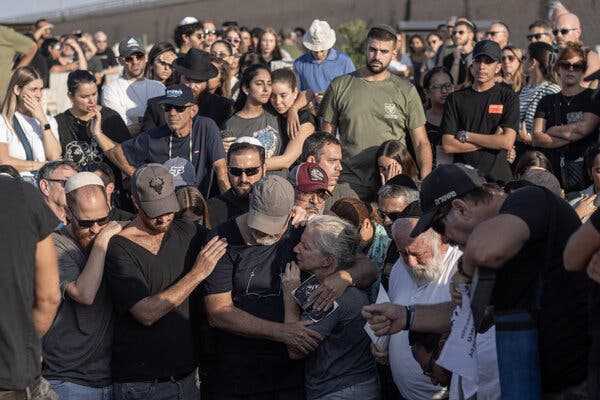Reports issued days before the Hamas attack did not foresee such a deadly strike, but did say rocket attacks were possible.
- Share full article

A funeral on Tuesday of one of the people killed by Hamas fighters on Saturday at a music festival near the Gaza border.
A pair of classified C.I.A. intelligence reports issued in the days ahead of a major Hamas attack on Israel warned about a potential escalation in violence but did not predict the complex, multipronged attack that Hamas gunmen launched against Israel days later, according to U.S. officials.
The first of the intelligence reports, dated Sept. 28, described the possibility that Hamas would launch rockets into Israel over a period of several days.
The second report, dated Oct. 5, built on the first but was shorter and more analytical.
The Oct. 5 report appeared in a daily C.I.A. summary of intelligence that is distributed widely to policymakers and lawmakers, the officials said. But intelligence officials did not brief either of the reports to President Biden or senior White House officials. Nor did the C.I.A. highlight the reports to White House policymakers as being of particular significance, officials said.
Several U.S. officials, who spoke on the condition of anonymity because of the sensitivity of the matter, described the reports as routine, and similar to other intelligence reports about the possibility of Palestinian violence that were written throughout the year.
One U.S. official familiar with the Sept. 28 report said it had language that warned of a possible escalation by Hamas through greater cross-border fire against Israel from Gaza.
C.I.A. analysts regularly write reports on violence between Israeli forces and Palestinian militants in the West Bank, which has escalated sharply in recent months. On the day the Oct. 5 report was disseminated, Hamas said two of its members in the West Bank were killed in a firefight with Israeli forces.
But the C.I.A. has recently put more focus on the risk of violence in the Gaza Strip, as evidenced by the recent agency reports, which described how dismal economic conditions in Gaza, where Hamas holds sway. They also said the group’s growing frustration about Israel’s longstanding blockade of the territory could lead to a resumption of border attacks.
C.I.A. and White House officials said they would not comment on classified documents.
While the reports warned of potential rocket fire, they did not say that Hamas intended to employ new tactics against Israel, such as a ground incursion.
It is unclear why Israeli intelligence agencies and their American counterparts did not detect preparations by Hamas for the Oct. 7 attack. Israeli intelligence agencies share a lot of intelligence from the Palestinian regions with their American counterparts.
The attack began with a large barrage of rockets. Hamas then launched the largest and deadliest incursion into Israel in decades, which left about 1,200 Israelis dead. Hamas gunmen are also holding about 150 hostages.
The failure to detect Hamas’s preparations has raised questions about whether the intelligence agencies misjudged the group’s capabilities and intentions, or had diverted resources to monitoring other threats. Hamas may also have found ways to prevent intelligence agencies from eavesdropping on their communications.
The reports were based on intelligence that the C.I.A. collected itself or received from partner services, the officials said, though they would not discuss the nature of that intelligence. They were written amid weeks of protests by young men in Gaza.
For many years, U.S. intelligence agencies have not made Hamas or the Gaza Strip a top priority, compared to other threats that they have tracked far more closely, including China, Russia, Iran, North Korea, Al Qaeda and the Islamic State.
Every year, U.S. intelligence agencies issue a report on major threats to global security. The 2023 report highlighted the threat faced by Israel from Iran, Hezbollah and “other partners and proxies,” without naming them.
The last time Hamas was mentioned in the annual report was 2017. Gaza has not been mentioned since 2013.
Since William J. Burns became director of the C.I.A. in 2021, he has warned, publicly and privately, that violence between Israelis and Palestinians could escalate, echoing comments by other American officials who work in the region.
In remarks at Georgetown University in February, Mr. Burns recalled his role as a senior diplomat two decades ago during the Palestinian uprising known as the Second Intifada.
“What we’re seeing today has a very unhappy resemblance to some of those realities that we saw then too,” he said.
More recently, Mr. Burns has warned of a risk that Israel’s adversaries could see growing divisions within Israeli society over the policies of Prime Minister Benjamin Netanyahu as an opportunity to step up their attacks against the Jewish state.
Eric Schmitt contributed reporting.
Julian E. Barnes covers the U.S. intelligence agencies and international security matters for The Times. He has written about security issues for more than two decades. More about Julian E. Barnes
Adam Entous is a Washington-based investigative correspondent and a two-time Pulitzer Prize winner. Before joining the Washington bureau of The Times, he covered intelligence, national security and foreign policy for The New Yorker magazine, The Washington Post and The Wall Street Journal. More about Adam Entous
Edward Wong is a diplomatic correspondent who has reported for The Times for more than 24 years from New York, Baghdad, Beijing and Washington. He was on a team of Pulitzer Prize finalists for Iraq War coverage. More about Edward Wong
Adam Goldman reports on the F.B.I. and national security from Washington, D.C., and is a two-time Pulitzer Prize winner. He is the coauthor of “Enemies Within: Inside the NYPD’s Secret Spying Unit and bin Laden’s Final Plot Against America.” More about Adam Goldman
- Share full article
SKIP ADVERTISEMENT
Source: nytimes.com



